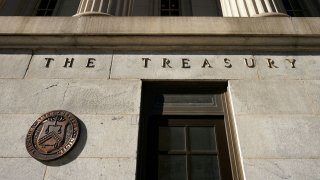- With government red ink swelling throughout the year, June saw a surplus of just over $27 billion, following a $316 billion deficit in May.
- Customs duties totaled about $27 billion for the month, up from $23 billion in May and a 301% gain from June 2024.
The U.S. government posted a surplus in June as tariffs gave an extra bump to a sharp increase in receipts, the Treasury Department said Friday.
Stream San Diego News for free, 24/7, wherever you are with NBC 7.
With government red ink swelling throughout the year, last month saw a surplus of just over $27 billion, following a $316 billion deficit in May.
That brought the fiscal year-to-date deficit to $1.34 trillion, up 5% from a year ago. However, with calendar adjustment, the deficit actually edged lower by 1%. There are three months left in the current fiscal year, which ends Sept. 30.
Get top local San Diego stories delivered to you every morning with our News Headlines newsletter.
A 13% increase in receipts from the same month a year ago helped bridge the gap, with outlays down 7%. For the year, receipts are up 7% while spending has risen 6%.
The government last posted a June surplus in 2017, during President
Donald Trump
‘s first term.
Increasing tariff collections are helping shore up the government finances.
Money Report
Tron’s Justin Sun says he’s buying another $100 million of Trump’s memecoin
TikTok loses bid to dismiss lawsuit alleging its ‘addictive design’ exploits kids
Customs duties totaled about $27 billion for the month, up from $23 billion in May and 301% higher than June 2024. On an annual basis, tariff collections have totaled $113 billion, or 86% more than a year ago.
Trump levied across-the-board 10% tariffs on imports in April on top of other select duties. He also announced a menu of so-called reciprocal tariffs on various U.S. trading partners and has been in negotiations since.
The Treasury Department noted that the month benefited from calendar adjustments, without which the deficit would have been $70 billion.
Persistently high Treasury yields again posed a challenge for federal finances.
Net interest on the $36 trillion national debt totaled $84 billion in June, down slightly from May but still higher than any other category with the exception of Social Security. For the year, net interest — what Treasury pays on the debt it issues minus what it earns on investments — is at $749 billion. Total interest payments are projected at $1.2 trillion for the full fiscal year.
Trump has been pushing the Federal Reserve to cut short-term rates to help with the financing burden of servicing federal debt. But markets don’t expect the central bank to ease again until September, and Fed Chair
Jerome Powell
has said he remains leery of the potential impact that tariffs might have on inflation.
Trump’s own “big beautiful” spending bill that made its way through Congress earlier this month is expected to add about $3.4 trillion to the national debt over the next decade, according to the nonpartisan Congressional Budget Office’s projections.
Clarification: This story has been updated to clarify the current deficit figures.
-
Morgan Stanley says buy these five stocks that are set to rally
-
Amazon shares form ‘golden cross’ as Prime Day kicks off
-
Investors expect bitcoin to break out to new records in the second half from a consolidation phase
-
Goldman Sachs says these buy-rated stocks offer solid dividends
Also on CNBC
-
Trump announces 35% tariffs on Canada starting Aug. 1, warns of higher levies
-
Inflation expectations drift back down to pre-tariff levels, NY Fed survey shows
-
Trump threatens extra 10% tariff on countries that align with BRICS policies







